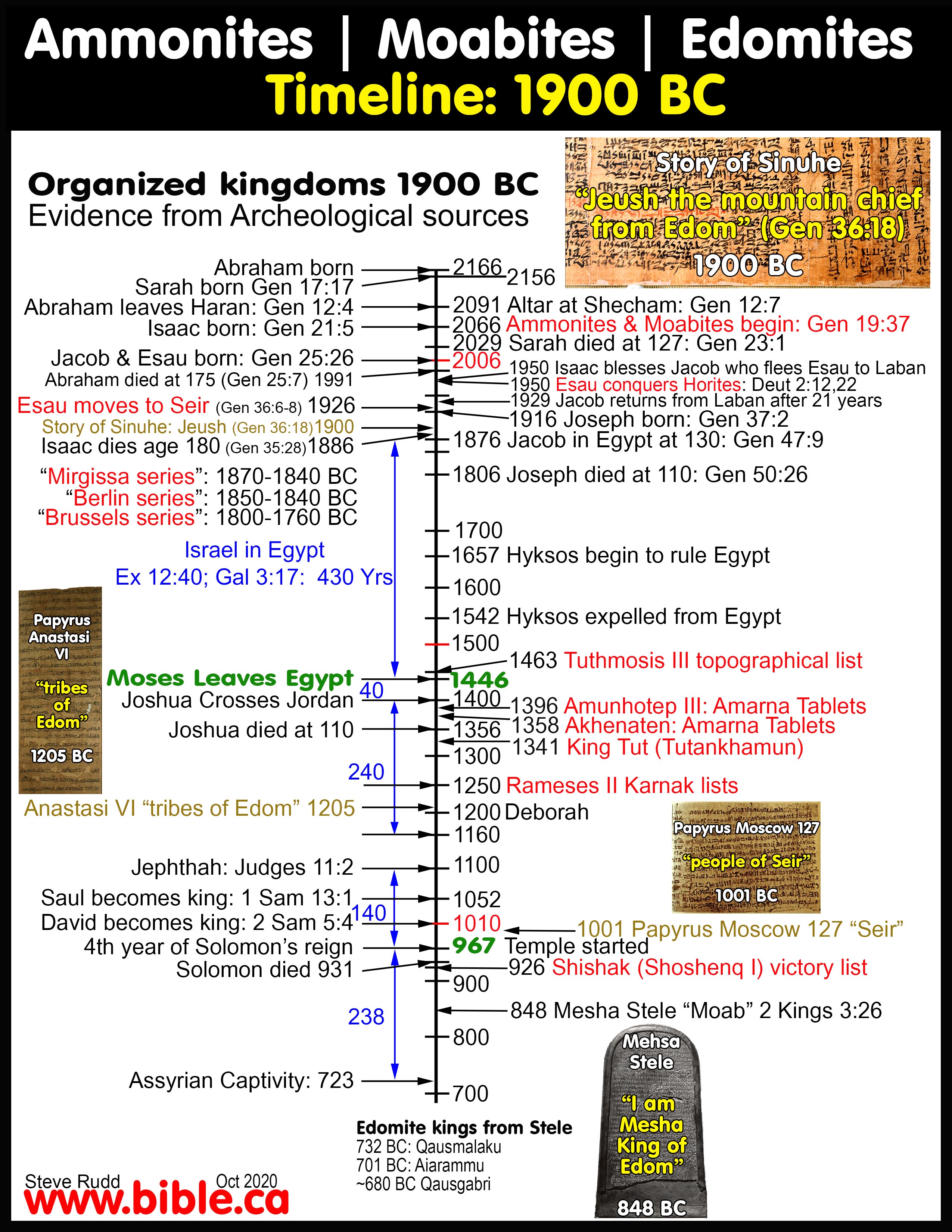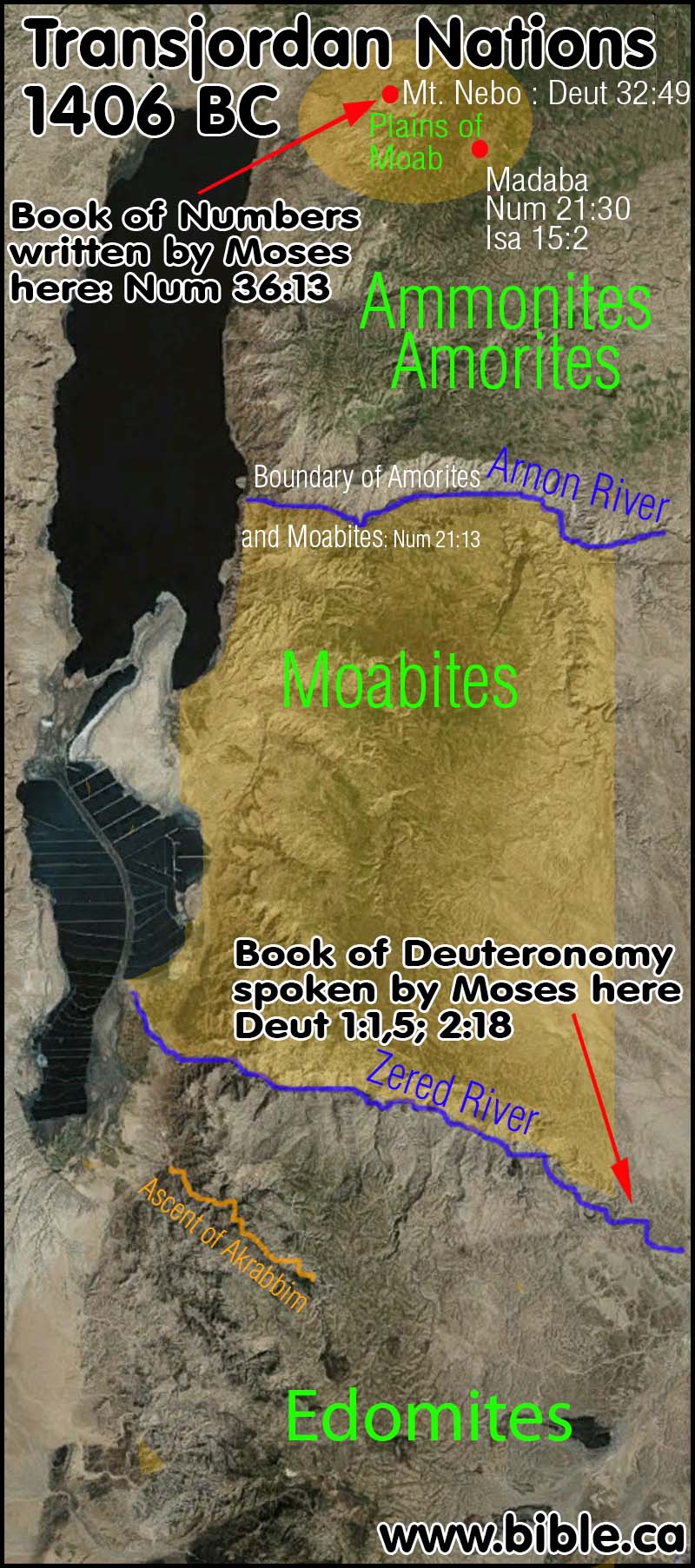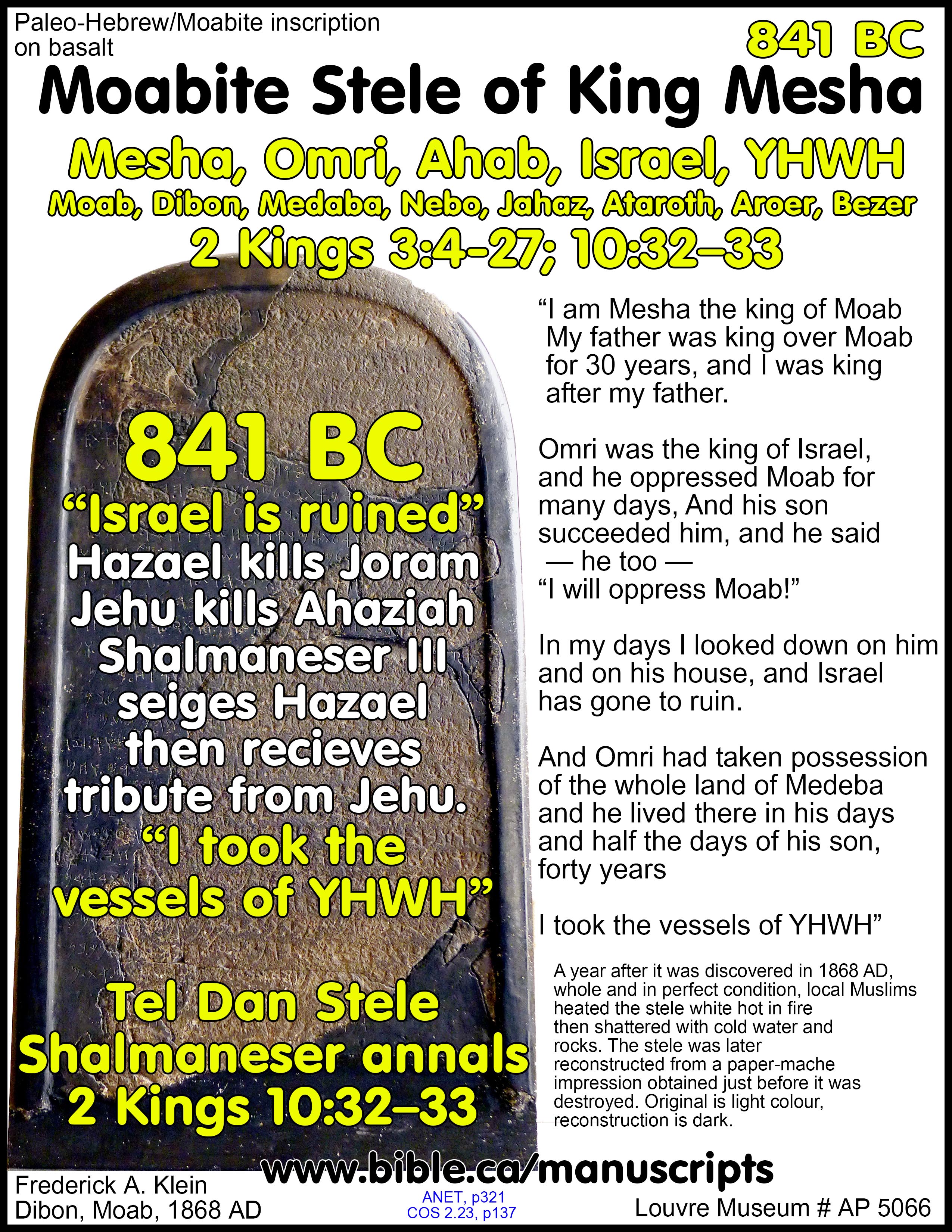The Moabites
See also: Nations of Bible lands
Introduction:
The Moabites were descendants of Lot through his daughters: "Thus both the daughters of Lot were with child by their father. The firstborn bore a son, and called his name Moab; he is the father of the Moabites to this day. As for the younger, she also bore a son, and called his name Ben-ammi; he is the father of the sons of Ammon to this day." Genesis 19:36-38
 At the time of the exodus, the Arnon River was the northern border of the Moabites next to the Amorites: Numbers 21:13
There appears to be a smaller territory called the "Plains of Moab" within Amorite land that included Mt. Nebo and Madaba: Deut 32:49
The Moabite Stone was discovered in 1868 in the town of Dibon which verified the historical accuracy of the Bible.
Moses had requested both Edom and Moab to pass through their land but were refused. This forces Israel to travel south to past Elat and Ezion geber, then due east for 20 miles then north to a location parallel with Jericho. Then asked permission for the Amorites to pass by their land so they could cross the Jordan. Judges 11:14-26
Judges 11:15-18 teaches us that the border between Moab and Edom, was and east west line that ran through Kadesh at Petra. Since Kadesh was right on the borders between Moab and Edom, they asked both Moab to pass from Petra north-east and Edom to pass south-east. Both refused.
Ruth was a Moabite woman who married Boaz and became the grandmother of King David.
At the time of the exodus, the Arnon River was the northern border of the Moabites next to the Amorites: Numbers 21:13
There appears to be a smaller territory called the "Plains of Moab" within Amorite land that included Mt. Nebo and Madaba: Deut 32:49
The Moabite Stone was discovered in 1868 in the town of Dibon which verified the historical accuracy of the Bible.
Moses had requested both Edom and Moab to pass through their land but were refused. This forces Israel to travel south to past Elat and Ezion geber, then due east for 20 miles then north to a location parallel with Jericho. Then asked permission for the Amorites to pass by their land so they could cross the Jordan. Judges 11:14-26
Judges 11:15-18 teaches us that the border between Moab and Edom, was and east west line that ran through Kadesh at Petra. Since Kadesh was right on the borders between Moab and Edom, they asked both Moab to pass from Petra north-east and Edom to pass south-east. Both refused.
Ruth was a Moabite woman who married Boaz and became the grandmother of King David.
A. Moabite Territory from Abraham to Conquest: 2000-1406BC
"From there they journeyed and camped on the other side of the Arnon, which is in the wilderness that comes out of the border of the Amorites, for the Arnon is the border of Moab, between Moab and the Amorites." Numbers 21:13
Plains of Moab: "These are the commandments and the ordinances which the Lord commanded to the sons of Israel through Moses in the plains of Moab by the Jordan opposite Jericho." Num 36:13
Mt. Nebo was part of Moab in 1406 BC: "Go up to this mountain of the Abarim, Mount Nebo, which is in the land of Moab opposite Jericho, and look at the land of Canaan, which I am giving to the sons of Israel for a possession." Deut 32:49
Madaba (Madaba Map) and Dibon (Moabite Stone) was part of Moab in 1406 BC: "But we have cast them down, Heshbon is ruined as far as Dibon, Then we have laid waste even to Nophah, Which reaches to Medeba." Num 21:30; "The sons of Gad built Dibon and Ataroth and Aroer" Num 32:34; "They have gone up to the temple and to Dibon, even to the high places to weep. Moab wails over Nebo and Medeba; Everyone's head is bald and every beard is cut off." Isa 15:2
B. Transjordan Moabite Territory at the Exodus is 1446BC
|

|
- This is how the three nations looked at the time of the exodus when Israel spent 38 years at Kadesh near Petra.
- Israel asked permission of Moab to cross their territory to go north and cross the Jordan river into the promised land and was refused.
- "and they said to him, "Thus says Jephthah, 'Israel did not take away the land of Moab nor the land of the sons of Ammon. 'For when they came up from Egypt, and Israel went through the wilderness to the Red Sea and came to Kadesh, then Israel sent messengers to the king of Edom, saying, "Please let us pass through your land," but the king of Edom would not listen. And they also sent to the king of Moab, but he would not consent. So Israel remained at Kadesh. 'Then they went through the wilderness and around the land of Edom and the land of Moab, and came to the east side of the land of Moab, and they camped beyond the Arnon; but they did not enter the territory of Moab, for the Arnon was the border of Moab." Judges 11:15-18
- Judges 11:15-18 teaches us that the border between Moab and Edom, was and east west line that ran through Kadesh at Petra.
|
Israel was forced to go from Petra south to the Red sea, then far east beyond Edom's and Moab's territory, then north. Once they were due east of the Arnon River, they traveled towards the Dead sea in the Arnon wadi valley until they came to the Kings Highway at Dibon. Then they started travelling north on the Kings Highway.
Moab's territory was both north and south of the Zered River because Israel adjacent to Moabite land before they headed north and camped in the Zered. "They journeyed from Oboth and camped at Iyeabarim, in the wilderness which is opposite Moab, to the east. From there they set out and camped in Wadi Zered." Numbers 21:11-12
Edom's land were south of Moab's down to Mt. Seir east of the Red Sea.
C. Amorite Territory after the conquest: 1380 - 950 BC
In 1406 BC, when the Israelites first came to the promised land, the Moabites controlled the transjordan from the Arnon River south to the Petra area which was the border of Edom.
At Kadesh, Moses had asked both Edom and Moab to cross their land and were refused.
Amortes living north of the Arnon River to pass through while at Kadesh (Petra), but was refused. They also asked asked the Amorites so they could pass travelling west to cross their land and get to the Jordan River. Unlike Edom, this time Israel fought: "Then Israel sent messengers to Sihon, king of the Amorites, saying, "Let me pass through your land. We will not turn off into field or vineyard; we will not drink water from wells. We will go by the king's highway until we have passed through your border." But Sihon would not permit Israel to pass through his border. So Sihon gathered all his people and went out against Israel in the wilderness, and came to Jahaz and fought against Israel. Then Israel struck him with the edge of the sword, and took possession of his land from the Arnon to the Jabbok, as far as the sons of Ammon; for the border of the sons of Ammon was Jazer. Israel took all these cities and Israel lived in all the cities of the Amorites, in Heshbon, and in all her villages." Numbers 21:21-25
"So Moses gave an inheritance to the tribe of the sons of Reuben according to their families. Their territory was from Aroer, which is on the edge of the valley of the Arnon, with the city which is in the middle of the valley and all the plain by Medeba; Heshbon, and all its cities which are on the plain: Dibon and Bamoth-baal and Beth-baal-meon, and Jahaz and Kedemoth and Mephaath, and Kiriathaim and Sibmah and Zereth-shahar on the hill of the valley, and Beth-peor and the slopes of Pisgah and Beth-jeshimoth, even all the cities of the plain and all the kingdom of Sihon king of the Amorites who reigned in Heshbon, whom Moses struck with the chiefs of Midian, Evi and Rekem and Zur and Hur and Reba, the princes of Sihon, who lived in the land." Joshua 13:15-21
D. The Moabite Stone (Stela of Mesha) discovered at Dibon
|

|
- The Moabite Stone was discovered by by Klein 1868 BC at the ancient city of Dibon.
- Before it could be fully documented, Muslims had smashed it to pieces because they superstitiously thought the black basalt stone had magical powers to protect their granaries. The Black stone in the Kabba at Mecca is a meteorite thought to have similar qualities which Muslims on their Hajj constantly kiss as they make their 7 counter-clockwise circles around the Black stone. (They only thought there were seven planets in 640 AD.)
- Only a fraction was found and put back together. It is presently housed in the Louvre in Paris, France.
|
The story on the Moabite Stone is a spectacular proof that the Bible is true history as told in 2 Kings 1:1; 3:4-27 "Now Mesha king of Moab was a sheep breeder, and used to pay the king of Israel 100,000 lambs and the wool of 100,000 rams."2 Ki 3:4
Mesha King of Moab, wrote the Moabite stone in about 900 BC.
The Stele is the oldest known evidence of the Tetragrammaton YHWH (Yahweh) as the personal name God revealed to Moses. It also references the tribe of Gad. It also references two known kings from the Bible: Omri the king of Israel and Mesha King of Moab. It also harmonizes with the Bible in that the King of Moab paid tribute to Omri. There are also references to building many cisterns for water which is possibly a reference to the miracle of water God used to defeat the Moabites.
Translation of the Moabite Stone: "I am Mesha, the son of Kemoš-yatti, the king of Moab, from Dibon. My father was king over Moab for thirty years, and I was king after my father. And in Karchoh I made this high place for Kemoš [...] because he has delivered me from all kings, and because he has made me look down on all my enemies. Omri was the king of Israel, and he oppressed Moab for many days, for Kemoš was angry with his land. And his son succeeded him, and he said -he too- "I will oppress Moab!" In my days he did so, but I looked down on him and on his house, and Israel has gone to ruin, yes, it has gone to ruin for ever! Omri had taken possession of the whole land of Medeba (Madaba) and he lived there in his days and half the days of his son, forty years, but Kemoš restored it in my days. And I built Baal Meon, and I made in it a water reservoir, and I built Kiriathaim. And the men of Gad lived in the land of Ataroth from ancient times, and the king of Israel built Ataroth for himself, and I fought against the city, and I captured, and I killed all the people from the city as a sacrifice for Kemoš and for Moab, and I brought back the fire-hearth of his Uncle from there, and I hauled it before the face of Kemoš in Kerioth, and I made the men of Sharon live there, as well as the men of Maharith. And Kemoš said to me: "Go, take Nebo from Israel!" And I went in the night, and I fought against it from the break of dawn until noon, and I took it, and I killed its whole population, seven thousand male citizens and aliens, female citizens and aliens, and servant girls; for I had put it to the ban of Aštar Kemoš. And from there, I took the vessels of YHWH, and I hauled them before the face of Kemoš. And the king of Israel had built Jahaz, and he stayed there during his campaigns against me, and Kemoš drove him away before my face, and I took two hundred men from Moab, all its division, and I led it up to Jahaz. And I have taken it in order to add it to Dibon. I have built Karchoh, the wall of the woods and the wall of the citadel, and I have built its gates, and I have built its towers, and I have built the house of the king, and I have made the double reservoir for the spring, in the innermost of the city. Now, there was no cistern in the innermost of the city, in Karchoh, and I said to all the people: "Make, each one of you, a cistern in his house." And I cut out the moat for Karchoh by means of prisoners from Israel. I have built Aroer, and I made the military road in the Arnon. I have built Beth Bamoth, for it had been destroyed. I have built Bezer, for it lay in ruins. And the men of Dibon stood in battle-order, for all Dibon, they were in subjection. And I am the king over hundreds in the towns which I have added to the land. And I have built the House of Medeba and the House of Diblathaim, and the House of Baal Meon, and I brought there [...] the flocks of the land. And Horonaim, there lived [...]. And Kemoš said to me: "Go down, fight against Horonaim!" I went down [...] and Kemoš restored it in my days. And [...] from there [...] And I [...]"
E. Summary of the domino effect: Rueben, Amorites, Moabites, Edomites
In a kind of domino effect one nation displaced another when Israel entered the promised land under Joshua.
Rueben displaced the Amorites from their stronghold and they moved south of the Arnon river and co-existed beside the Moabites.
The Edomites were in turn, probably forced south into their historic stronghold area at Mt. Seir, just north east of the Red Sea. Edom remained transjordan from the time of the Exodus. It was not until the Babylonian captivity did Edom first move into the land of Judah.
When Israel first arrived at Kadesh (Petra) it was on the border of the Edomites.
When Israel first crossed the Jordan with Joshua, the Amorites controlled both Hebron, Jerusalem and Engedi. They were defeated and driven transjordan between the time of Joshua to David. Of course under David and Solomon, they were completely driven east and south of the entire transjordan area for a time, until the Assyrian captivity in 722 BC.
By Steve Rudd: Contact the author for comments, input or corrections.

Go To Start: WWW.BIBLE.CA
